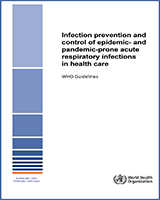
NCBI Bookshelf. A service of the National Library of Medicine, National Institutes of Health.
Infection Prevention and Control of Epidemic- and Pandemic-Prone Acute Respiratory Infections in Health Care. Geneva: World Health Organization; 2014.

Stock the sink area with suitable supplies for handwashing, and with alcohol-based hand rub, near the point of care and the room door.
Ensure adequate room ventilation. Post signs on the door indicating that the space is an isolation area.Ensure that visitors consult the health-care worker in charge (who is also responsible for keeping a visitor record) before being allowed into the isolation areas. Keep a roster of all staff working in the isolation areas, for possible outbreak investigation and contact tracing.
Remove all non-essential furniture and ensure that the remaining furniture is easy to clean, and does not conceal or retain dirt or moisture within or around it.
Stock the PPE supply and linen outside the isolation room or area (e.g. in the change room). Setup a trolley outside the door to hold PPE. A checklist may be useful to ensure that all equipment isavailable (see sample checklist in Section E.3, below).
Place appropriate waste bags in a bin. If possible, use a touch-free bin. Ensure that used (i.e. dirty) bins remain inside the isolation rooms.
Place a puncture-proof container for sharps disposal inside the isolation room or area.Keep the patient's personal belongings to a minimum. Keep water pitchers and cups, tissue wipes, and all items necessary for attending to personal hygiene, within the patient's reach.
Dedicate non-critical patient-care equipment (e.g. stethoscope, thermometer, blood pressure cuff and sphygmomanometer) to the patient, if possible. Thoroughly clean and disinfect patient-care equipment that is required for use by other patients before use.
Place an appropriate container with a lid outside the door for equipment that requires disinfection or sterilization.
Keep adequate equipment required for cleaning or disinfection inside the isolation room or area, and ensure scrupulous daily cleaning of the isolation room or area.
Set up a telephone or other method of communication in the isolation room or area to enable patients, family members or visitors to communicate with health-care workers. This may reduce the number of times the workers need to don PPE to enter the room or area.
Before entering the isolation room or area:
collect all equipment needed;perform hand hygiene with an alcohol-based hand rub (preferably when hands are not visibly soiled) or soap and water;
put on PPE in the order that ensures adequate placement of PPE items and preventsself-contamination and self-inoculation while using and taking off PPE; an example of the order inwhich to don PPE when all PPE items are needed is hand hygiene, gown, mask or respirator, eyeprotection and gloves, as illustrated in Fig. E.1A, below.
Putting on and removing personal protective equipment.
Either remove PPE in the anteroom or, if there is no anteroom, make sure that the PPE will not contaminate either the environment outside the isolation room or area, or other people.
Remove PPE in a manner that prevents self-contamination or self-inoculation with contaminated PPE or hands. General principles are:
Perform hand hygiene with an alcohol-based hand rub (preferably) or soap and water whenever ungloved hands touch contaminated PPE items.
The following items should be kept on the trolley at all times so that PPE is always available for health-care workers.
reusable vinyl or rubber gloves for environmental cleaning latex single-use gloves for clinical care single-use long-sleeved fluid-resistant or reusable non-fluid-resistant gownsplastic aprons (for use over non-fluid-resistant gowns if splashing is anticipated and if fluid-resistant gowns are not available)
For more information on isolation precautions, see:
Practical guidelines for infection control in health care facilities, 2004 (212) Prevention of hospital-acquired infections: A practical guide, 2002 (213).For additional information on hand hygiene, see:
WHO guidelines on hand hygiene in health care, 2009 (215). Copyright © World Health Organization 2014.All rights reserved. Publications of the World Health Organization are available on the WHO web site (www.who.int) or can be purchased from WHO Press, World Health Organization, 20 Avenue Appia, 1211 Geneva 27, Switzerland (tel.: +41 22 791 3264; fax: +41 22 791 4857; e-mail: tni.ohw@sredrokoob).
Requests for permission to reproduce or translate WHO publications –whether for sale or for non-commercial distribution– should be addressed to WHO Press through the WHO website (www.who.int/about/licensing/copyright_form/en/index.html).
Bookshelf ID: NBK214341Infection Prevention and Control of Epidemic- and Pandemic-Prone Acute Respiratory Infections in Health Care. Geneva: World Health Organization; 2014. Annex E, Isolation rooms or areas.
Isolation rooms or areas - Infection Prevention and Control of Epidemic- and Pandemic-Prone Acute Respiratory Infections in Health Care
Your browsing activity is empty.
Activity recording is turned off.